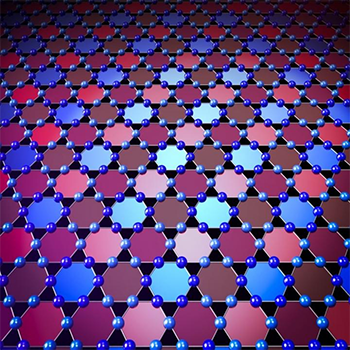Understanding Kagome Materials: A Comprehensive Guide
Definition: Kagome materials are a unique class of crystalline structures distinguished by their two-dimensional, trihexagonal tiling, which resembles the traditional Japanese basket-weaving pattern known as kagome. This intricate arrangement of atoms leads to fascinating electronic properties, including flat electronic bands and Dirac points, making them a hot topic in condensed matter physics and materials science.

Definition and Fundamental Properties
Kagome materials are defined by their distinctive lattice structure, which is characterized by a pattern of corner-sharing triangles that form a two-dimensional network. This structure is not only aesthetically similar to the kagome weaving pattern but also results in unique physical properties, such as frustrated magnetism and the presence of flat bands in their electronic structure.
What Are Kagome Materials?
Kagome materials are a class of materials characterized by their distinct lattice structure, reminiscent of a traditional Japanese basket-weaving pattern known as "kagome". This structure features a two-dimensional network of corner-sharing triangles, creating a highly frustrated magnetic system due to the geometric arrangement of its magnetic atoms. This frustration leads to exotic magnetic properties and the potential for novel quantum states, including quantum spin liquids and topological electronic states.
How Do Kagome Materials Work?
The exotic physical phenomena observed in kagome materials arise from their special geometric arrangement. The flat bands, which are a hallmark of these materials, lead to strongly correlated electron systems. This means that electrons in these bands are highly localized, enhancing electron-electron interactions and potentially leading to unconventional superconductivity and magnetic orders.
Furthermore, the Dirac points in kagome lattices, similar to those found in graphene, contribute to high mobility of charge carriers, making these materials promising for electronic applications.
The Kagome Lattice: Structure and Significance
At the heart of kagome materials is the kagome lattice, a geometric pattern of interlaced triangles that form a repetitive, tessellated design. This structure is not merely aesthetic but plays a crucial role in the material's physical properties. The arrangement of atoms in this pattern leads to reduced magnetic ordering temperatures and the emergence of exotic ground states, primarily due to the enhanced quantum fluctuations and magnetic frustration inherent in the lattice.
Notable Kagome Materials and Their Properties
Several materials exemplify the unique properties of the kagome lattice:
- Herbertsmithite (ZnCu3(OH)6Cl2): Perhaps the most studied kagome material, Herbertsmithite is a mineral where copper ions form a perfect kagome lattice. It is a prime candidate for realizing a quantum spin liquid state, as it exhibits no magnetic order down to very low temperatures, hinting at the presence of highly entangled quantum states.
- FeSn: This metallic kagome material has attracted interest for its unusual electronic properties and potential as a platform for exploring topological quantum phenomena. FeSn exhibits a large anomalous Hall effect, a property linked to the material's topological electronic structure.
- Mn3Sn: Known for its antiferromagnetic kagome lattice, Mn3Sn exhibits a large anomalous Hall effect and is studied for its potential applications in antiferromagnetic spintronics. The material's non-collinear magnetic ordering on the kagome lattice underpins its novel magnetic and electronic behaviors.
Key Features of Kagome Materials
Kagome materials stand out due to their:
- Exotic Magnetic Properties: The geometric frustration in kagome lattices leads to complex magnetic states, including quantum spin liquids, which are of significant interest for quantum computing.
- Electronic Properties: Flat bands and Dirac cones in their electronic structure suggest potential applications in high-speed electronics and spintronics.
- Topological Characteristics: Kagome materials exhibit interesting topological states, making them candidates for exploring new quantum phenomena.
- Potential for Superconductivity: The strong electron correlations and unique electronic structure suggest a pathway to unconventional superconductivity.
Applications of Kagome Materials
The remarkable properties of kagome materials have implications for a range of applications:
- Quantum Computing: The potential for hosting quantum spin liquid states makes them interesting for quantum information processing.
- Advanced Electronics: Their unique electronic properties could lead to the development of novel electronic and spintronic devices.
- Energy Storage: The high surface area and unique electronic properties may be beneficial for developing advanced battery materials.
- Photonic Devices: The topological and photonic properties of kagome lattices can be exploited in designing novel optical devices.
Recent Technological Advancements in Kagome Materials
Recent breakthroughs in synthesizing and manipulating kagome materials have opened up new avenues for their application. Innovations in material processing and characterization techniques have allowed scientists to better understand and utilize the unique properties of kagome lattices. Additionally, theoretical advancements have provided deeper insights into the electronic, magnetic, and topological behaviors of these materials, guiding experimental efforts towards practical applications.
Kagome materials are also being explored for their potential in sustainable technologies, such as photocatalysis for water splitting and carbon dioxide reduction. Their unique electronic structure can be harnessed to improve the efficiency of these processes, contributing to cleaner energy solutions.
Challenges and Future Directions
Despite their promising properties, kagome materials face challenges, particularly in synthesis and characterization. High-quality single crystals are often difficult to produce, and understanding the complex interplay between their structure, magnetism, and electronic properties requires advanced techniques and theoretical models. Future research is directed towards overcoming these challenges, synthesizing new kagome materials, and unraveling their quantum phenomena, potentially revolutionizing various technology sectors.
Further Reading
Nature Reviews Physics, Quantum states and intertwining phases in kagome materials
